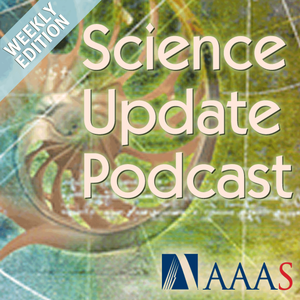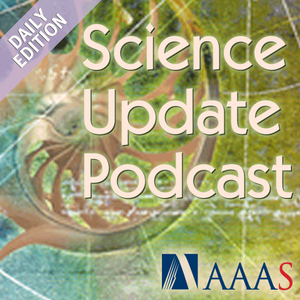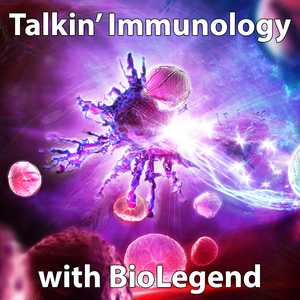
Science Signaling Podcast
Annalisa VanHook
Science Signaling Podcast
- 37 minutes 36 secondsTesting whales’ hearing, and mapping clusters of extreme longevity
First up this week, where on Earth do people live the longest? What makes those places or people so special? Genes, diet, life habits? Or could it be bad record keeping and statistical flukes? Freelance science journalist Ignacio Amigo joins host Sarah Crespi to discuss the controversies around so-called blue zones—regions in the world where clusters of people appear to have extreme longevity.
Next on the show, producer Kevin Mclean talks with Dorian Houser, director of conservation biology at the National Marine Mammal Foundation. Houser and colleagues temporarily captured juvenile minke whales and tested their hearing. It turns out these baleen whales have more sensitive hearing than predicted from vocalizations and anatomical modeling, which could change our understanding of how they are affected by underwater noise pollution.
This week’s episode was produced with help from Podigy.
Authors: Sarah Crespi; Ignacio Amigo; Kevin McLean
Learn more about your ad choices. Visit megaphone.fm/adchoices
21 November 2024, 7:00 pm - 32 minutes 20 secondsResurrecting a ‘flipping ship,’ and solving the ‘bone paradox’ in ancient remains
First up this week, a ship that flips for science. Sean Cummings, a freelance science journalist, joins host Sarah Crespi to talk about the resurrection of the Floating Instrument Platform (R/V FLIP), a research vessel built by the U.S. Navy in the 1960s and retired in 2023. FLIP is famous for turning vertically 90° so the bulk of the long ship is underwater, stabilizing it for data gathering. Additional audio from Scripps Institution of Oceanography. Watch FLIP flipping here.
Next on the show, viewing past lives using bones from medieval London cemeteries. Samantha Yaussy, a professor in the Department of Sociology and Anthropology at James Madison University, joins Sarah to talk about a bony paradox. Do lesions or scars on buried bones mean the person was frail and ill when they lived or were they strong and resilient because they survived long enough for disease to damage their bones?
This week’s episode was produced with help from Podigy.
Authors: Sarah Crespi; Sean Cummings
Learn more about your ad choices. Visit megaphone.fm/adchoices
14 November 2024, 7:00 pm - 26 minutes 4 secondsWatching continents slowly break apart, and turbo charging robotic sniffers
First up this week, Staff Writer Paul Voosen talks with host Sarah Crespi about his travel to meet up with a lead researcher in the field, Folarin Kolawole, and the subtle signs of rifting on the African continent.
Next on the show, Nik Dennler, a Ph.D. student in the Biocomputation Group at the University of Hertfordshire and the International Center for Neuromorphic Systems at Western Sydney University, discusses speeding up electronic noses. These fast sniffing devices could one day be mounted on drones to help track down forest fires before they are large enough to spot with a satellite.
This week’s episode was produced with help from Podigy.
Authors: Sarah Crespi; Paul Voosen
Learn more about your ad choices. Visit megaphone.fm/adchoices
7 November 2024, 7:00 pm - 39 minutes 40 secondsThe challenges of studying misinformation, and what Wikipedia can tell us about human curiosity
First up this week, Contributing Correspondent Kai Kupferschmidt joins host Sarah Crespi to discuss the difficulties of studying misinformation. Although misinformation seems like it’s everywhere, researchers in the field don’t agree on a common definition or shared strategies for combating it.
Next, what can Wikipedia tell us about human curiosity? Dani Bassett, a professor in the department of bioengineering at the University of Pennsylvania, observed three different curiosity styles in people browsing the online encyclopedia—hunter, busybody, and dancer. They explain characteristics of each style and how which approach you use could depend on where you live.
This week’s episode was produced with help from Podigy.
Episode page: https://www.science.org/doi/10.1126/science.zpuwynf
Authors: Sarah Crespi; Kai Kupferschmidt
Learn more about your ad choices. Visit megaphone.fm/adchoices
31 October 2024, 6:00 pm - 46 minutes 48 secondsPaleorobotics, revisiting the landscape of fear, and a book on the future of imagination
Using robots to study evolution, the last installment of our series of books on a future to look forward to, and did reintroducing wolves really restore an ecosystem?
First up this week, a new study of an iconic ecosystem doesn’t support the “landscape of fear” concept. This is the idea that bringing back apex predators has a huge impact on the behavior of their prey, eventually altering the rest of the ecosystem. Host Sarah Crespi talks with Contributing Correspondent Virginia Morell about the findings.
Next, using bioinspired robotics to explore deep time. Michael Ishida, a postdoctoral researcher in the Bio-Inspired Robotics Lab at the University of Cambridge, talks about studying key moments in evolutionary history, such as the transition from water to land by creating robotic versions of extinct creatures.
Finally in the last in our series of books on an optimistic future, books host Angela Saini talks with
Ruha Benjamin, a professor of African American studies at Princeton University and recently named MacArthur Fellow. The two discuss Benjamin’s latest book, Imagination: A Manifesto, which explores the part that imagination plays in creating new and radical futures.
This week’s episode was produced with help from Podigy.
Episode page: https://www.science.org/doi/10.1126/science.zu8ch5j
Authors: Sarah Crespi; Angela Saini; Virginia Morell
Learn more about your ad choices. Visit megaphone.fm/adchoices
24 October 2024, 6:00 pm - 40 minutes 25 secondsHow to deal with backsliding democracies, and balancing life as a scientist and athlete
First up this week, host Sarah Crespi talks to Jon Chu, a presidential young professor in international affairs at the Lee Kuan Yew School of Public Policy at the National University of Singapore, about how people around the world define democracy. Does democracy mean elections, freedom of the press, social mobility, or something else? Chu’s team found there was common ground across six countries. In many places with backsliding democracies, leaders may be tempted to change the definition of democracy to their own ends—this study suggests the people they rule won’t be fooled.
Next, when staying at home meant choosing between chemistry and basketball, Lena Svanholm sought an opportunity in the U.S. to pursue both. She joins producer Kevin McLean to discuss her next steps in balancing dual careers in science and professional sports.
In a sponsored segment from the Science/AAAS Custom Publishing Office, Erika Berg, director and senior editor of Custom Publishing, interviews Michal Elovitz about gaps in women’s health research. This segment is sponsored by the Icahn School of Medicine at Mount Sinai.
This week’s episode was produced with help from Podigy.
Authors: Sarah Crespi; Kevin McLean; Lena E. H. Svanholm
Learn more about your ad choices. Visit megaphone.fm/adchoices
17 October 2024, 6:00 pm - 32 minutes 16 secondsGraphene’s journey from hype to prime time, and harvesting lithium from briny water
First up this week, we celebrate 20 years of graphene—from discovery, to hype, and now reality as it finally finds its place in technology and science. Science journalist Mark Peplow joins host Sarah Crespi to discuss graphene’s bumpy journey.
Next, producer Meagan Cantwell talks with Seth Darling, chief science and technology officer for the Advanced Energy Technologies Directorate at Argonne National Laboratory, about two new ways to harvest lithium from water. One approach harnesses sunlight to pull water up through a membrane and collect lithium, whereas the other uses an electrochemical cell to selectively suck lithium up. Finding efficient ways to extract lithium from sources where it’s lower in concentration, such as the ocean, will be crucial as demand increases.
This week’s episode was produced with help from Podigy.
Authors: Sarah Crespi; Meagan Cantwell; Mark Peplow
Episode page: https://www.science.org/doi/10.1126/science.zn17zjt
Learn more about your ad choices. Visit megaphone.fm/adchoices
10 October 2024, 6:00 pm - 28 minutes 40 secondsScientific evidence that cats are liquids, and when ants started their fungus farms
First up this week, online editor David Grimm joins host Sarah Crespi to talk about how cats think about their own bodies. Do cats think of themselves as a liquid, as much the internet appears to believe? New experiments suggest they may—but only in one dimension.
Next, freelance producer Ariana Remmel is joined by Ted Schultz, a research entomologist at the Smithsonian Institution, to discuss the evolution of ant-fungus farming. It turns out, ants and fungus got together when the earth was going through some really tough times around 66 million years ago.
This week’s episode was produced with help from Podigy.
Authors: Sarah Crespi; Ariana Remmel; David Grimm
Episode page: https://www.science.org/doi/10.1126/science.zlav1o2
Learn more about your ad choices. Visit megaphone.fm/adchoices
3 October 2024, 6:00 pm - 48 minutes 55 secondsBurying trees to lock up carbon, notorious ‘Alzheimer’s gene’ fuels hope, and a book on virtual twins
The gene variant APOE4 is finally giving up some of its secrets, how putting dead trees underground could make carbon sequestration cheap and scalable, and the latest in our series of books on an optimistic future
First up this week, Staff Writer and Editor Jocelyn Kaiser joins host Sarah Crespi to discuss APOE4, a gene linked with a higher risk of Alzheimer’s disease. They talk about new research into why APOE4 might be a good target for preventing or treating this dreaded neurodegenerative disease.
Next, Ning Zeng, a professor in the Department of Atmospheric & Oceanic Science and at the Earth System Science Interdisciplinary Center at the University of Maryland, joins the show to discuss an unusual approach to carbon sequestration and a very old piece of wood. He talks about how an unearthed 3000-year-old log that has held on to most of its carbon is pretty good proof that we can efficiently put carbon underground at low cost by burying trees.
Finally, we have the latest in our series of books on a future to look forward to. Books host Angela Saini talks with Peter Coveney and Roger Highfield, the two authors of the book Virtual You: How Building Your Digital Twin Will Revolutionize Medicine and Change Your Life.
This week’s episode was produced with help from Podigy.
Episode page: https://www.science.org/doi/10.1126/science.z8oerdq
Authors: Sarah Crespi; Jocelyn Kaiser; Angela Saini
Learn more about your ad choices. Visit megaphone.fm/adchoices
26 September 2024, 6:00 pm - 44 minutes 51 secondsLooking for life on an icy moon, and feeling like a rat
First up this week, a preview of a NASA mission to Jupiter’s icy moon Europa. Science journalist Robin Andrews joins host Sarah Crespi to talk about the Clipper mission and what it could reveal about the habitability of the world that lies beneath Europa’s chaotic, icy surface.
Next, what does it feel like to be a rat? This week Science has a special issue on rats, focusing on their contributions to science, their history as invasives and disease carriers, and more. But Inbal Ben-Ami Bartal, a professor in the School of Psychological Sciences and the Sagol School of Neuroscience at Tel Aviv University, is here to talk about their capacity for empathy and other positive emotions.
In a sponsored segment from the Science/AAAS Custom Publishing Office, Erika Berg, director and senior editor of custom publishing, interviews University of Manchester professor Sarah Haigh about the past, present, and future of graphene. This segment is sponsored by Zeiss.
This week’s episode was produced with help from Podigy.
Authors: Sarah Crespi; Robin Andrews
Episode page: https://www.science.org/doi/10.1126/science.zapddvc
Learn more about your ad choices. Visit megaphone.fm/adchoices
19 September 2024, 6:00 pm - 28 minutes 32 secondsHail finally gets its scientific due, and busting up tumors with ultrasound
Why don’t we know what is happening with hail? It’s extremely destructive and costs billions of dollars in property damage every year. We aren’t great at predicting hailstorms and don’t know much about how climate change will affect them, but scientists are working to change that. News Intern Hannah Richter joins host Sarah Crespi to discuss deploying new technologies in this long-neglected area of research.
Next on the show, ultrasound—it’s not just for looking inside the body anymore. Meaghan O’Reilly is a senior scientist in physical sciences at the Sunnybrook Research Institute, an associate professor of medical biophysics at the University of Toronto, and is the Canada Research Chair in biomedical ultrasound. She talks about how researchers are using focused sound waves to disrupt tumors, change the permeability of the blood-brain barrier, stimulate the immune system, and more.
This week’s episode was produced with help from Podigy.
Authors: Sarah Crespi; Hannah Richter
Episode page: https://www.science.org/doi/10.1126/science.zm3x6zq
About the Science Podcast: https://www.science.org/content/page/about-science-podcast
Learn more about your ad choices. Visit megaphone.fm/adchoices
12 September 2024, 6:00 pm - More Episodes? Get the App
Your feedback is valuable to us. Should you encounter any bugs, glitches, lack of functionality or other problems, please email us on [email protected] or join Moon.FM Telegram Group where you can talk directly to the dev team who are happy to answer any queries.
 Weekly Show – Science Update
Weekly Show – Science Update
 BioLogic
BioLogic
 Cell Podcast
Cell Podcast
 Science Update Podcast - Daily Edition
Science Update Podcast - Daily Edition
 The Journal of Immunology ImmunoCasts
The Journal of Immunology ImmunoCasts
 Talkin Immunology with BioLegend
Talkin Immunology with BioLegend